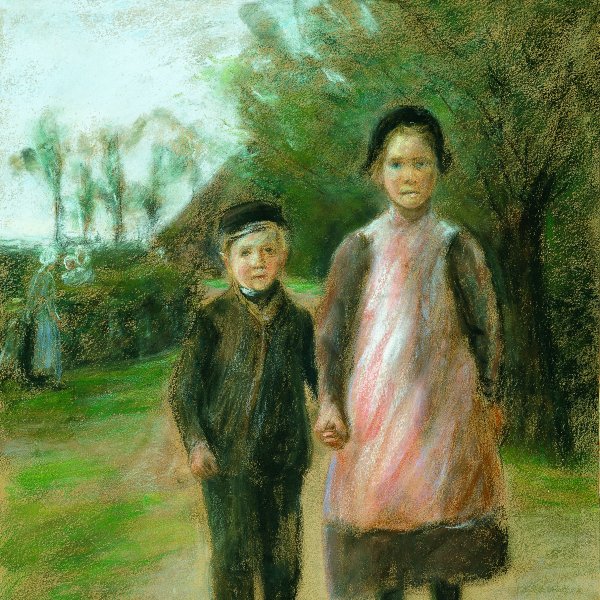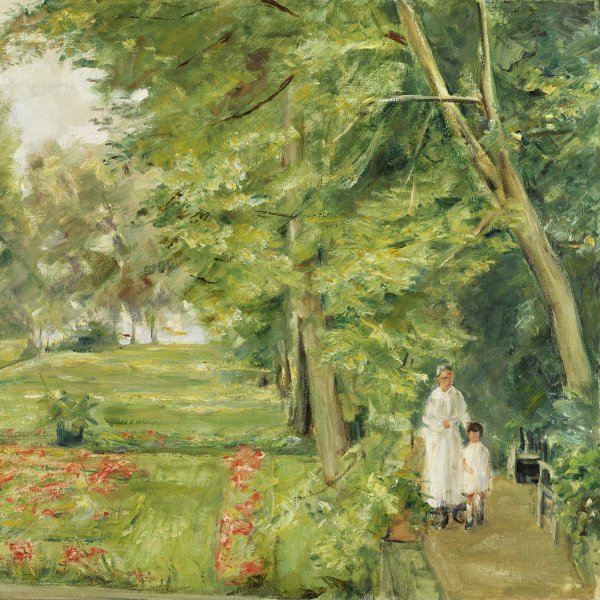Max Liebermann
Berlín, 1847-1935
Max Liebermann enrolled in the Department of Philosophy of Berlin University in 1866, while at the same time he attended drawing classes in the atelier of Karl Steffeck. In 1869 he entered the Kunsthochschule in Weimar, and was taught by Ferdinand Wilhelm Pauwels, Charles Verlat and Paul Thumann. In 1871 he travelled to Düsseldorf with Theodor Hagen. On that occasion he visited the painter Mihály Munkácsy, who influenced his first naturalist works, which earned him the name of "apostle of ugliness". The following year, in 1872, after finishing his studies at the Kunsthochschule in Weimar, he travelled to Paris, where he was attracted to the work of Gustave Courbet and Jean-François Millet. Liebermann lived in the French capital from 1874 to 1878. He also took advantage of the summers to travel to Holland, where he copied works by Frans Hals. He moved to Munich in 1878, but his painting was not received as he expected, and he was even accused of "blasphemy" for painting his Christ in the Temple (1879) in a crudely realist style. His works from this period reveal the influence of Wilhelm Leibl, one of the few painters he befriended in the Bavarian capital. Having returned to his native city in 1884, Liebermann produced some of his most famous works, such as Flax Barn in Laren (1887), one of the emblems of German Naturalism.
From the end of the 1880s-following his two trips to Holland in 1886 and 1887, in which he befriended Jozef Israëls-Liebermann's art shows a greater interest in nature and its capacity to evoke feelings and states of mind. But the real change in his art came in 1895, when he adopted the Impressionist style. From that moment his palette became brighter and more colourful, and he abandoned the motifs from the rural world in favour of scenes depicting the leisure activities of the bourgeoisie on beaches, spas, shows, etc. His interest in French Impressionist painting led him to collect many works by Manet, Degas, Monet and Cézanne.
Fame arrived quickly for Liebermann. He soon became one of the most sought-after portrait painters in the intellectual world of Berlin. In 1898 he was appointed president of the Berlin Secession, a post he held until 1911, when the crisis provoked by his opposition to the German Expressionism made him resign. In 1903 he was also appointed president of the Deutscher Künstlerbund and in 1920 president of the Akademie der Künste.
In the last years of his life he retired to the banks of the Wannsee Lake. There, he painted many self-portraits, portraits of his granddaughter and views of his garden, in works characterised by a vibrant brushstroke and bright colours. Relentlessly harassed by the Nazis, Liebermann died in his native Berlin on 8 February 1935.
Juan Á. López-Manzanares
From the end of the 1880s-following his two trips to Holland in 1886 and 1887, in which he befriended Jozef Israëls-Liebermann's art shows a greater interest in nature and its capacity to evoke feelings and states of mind. But the real change in his art came in 1895, when he adopted the Impressionist style. From that moment his palette became brighter and more colourful, and he abandoned the motifs from the rural world in favour of scenes depicting the leisure activities of the bourgeoisie on beaches, spas, shows, etc. His interest in French Impressionist painting led him to collect many works by Manet, Degas, Monet and Cézanne.
Fame arrived quickly for Liebermann. He soon became one of the most sought-after portrait painters in the intellectual world of Berlin. In 1898 he was appointed president of the Berlin Secession, a post he held until 1911, when the crisis provoked by his opposition to the German Expressionism made him resign. In 1903 he was also appointed president of the Deutscher Künstlerbund and in 1920 president of the Akademie der Künste.
In the last years of his life he retired to the banks of the Wannsee Lake. There, he painted many self-portraits, portraits of his granddaughter and views of his garden, in works characterised by a vibrant brushstroke and bright colours. Relentlessly harassed by the Nazis, Liebermann died in his native Berlin on 8 February 1935.
Juan Á. López-Manzanares






